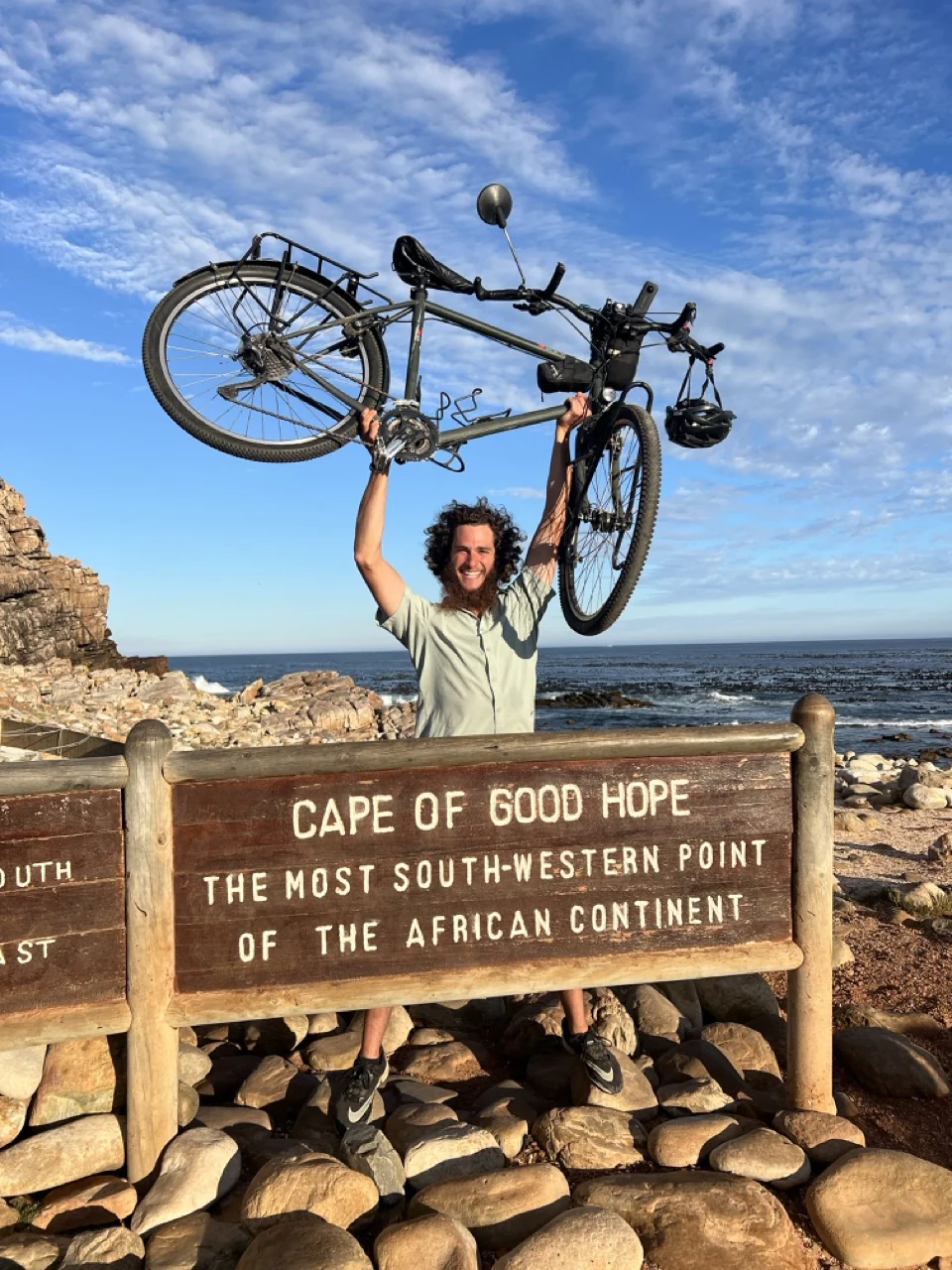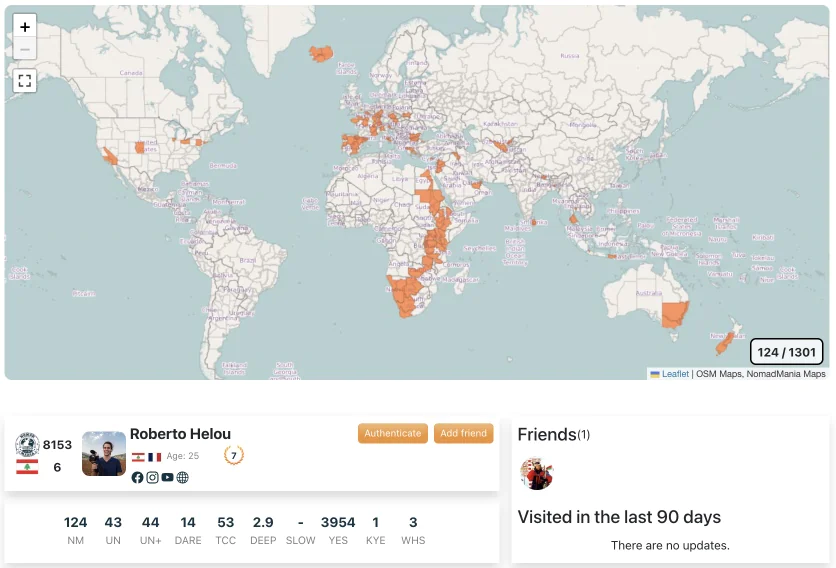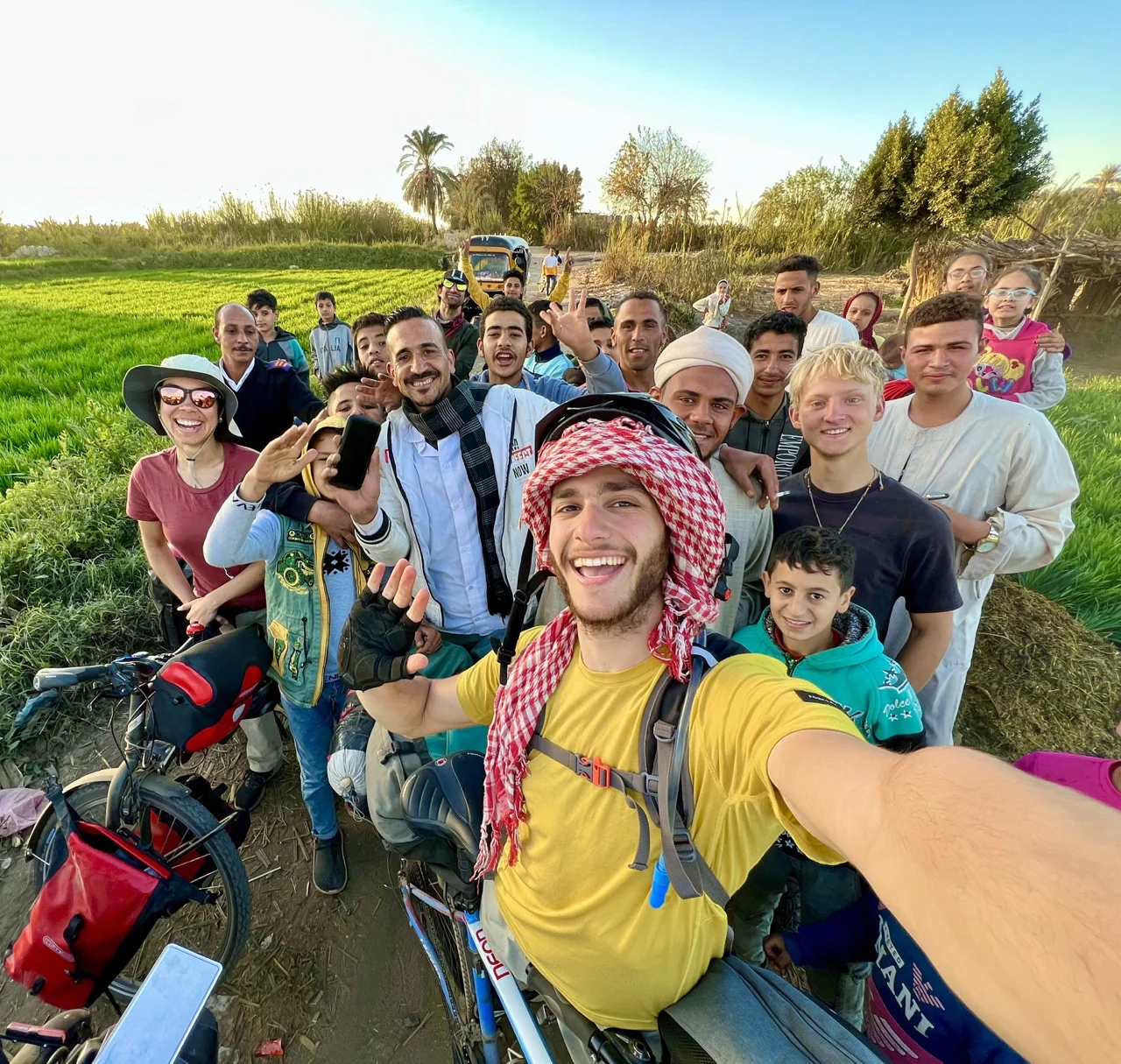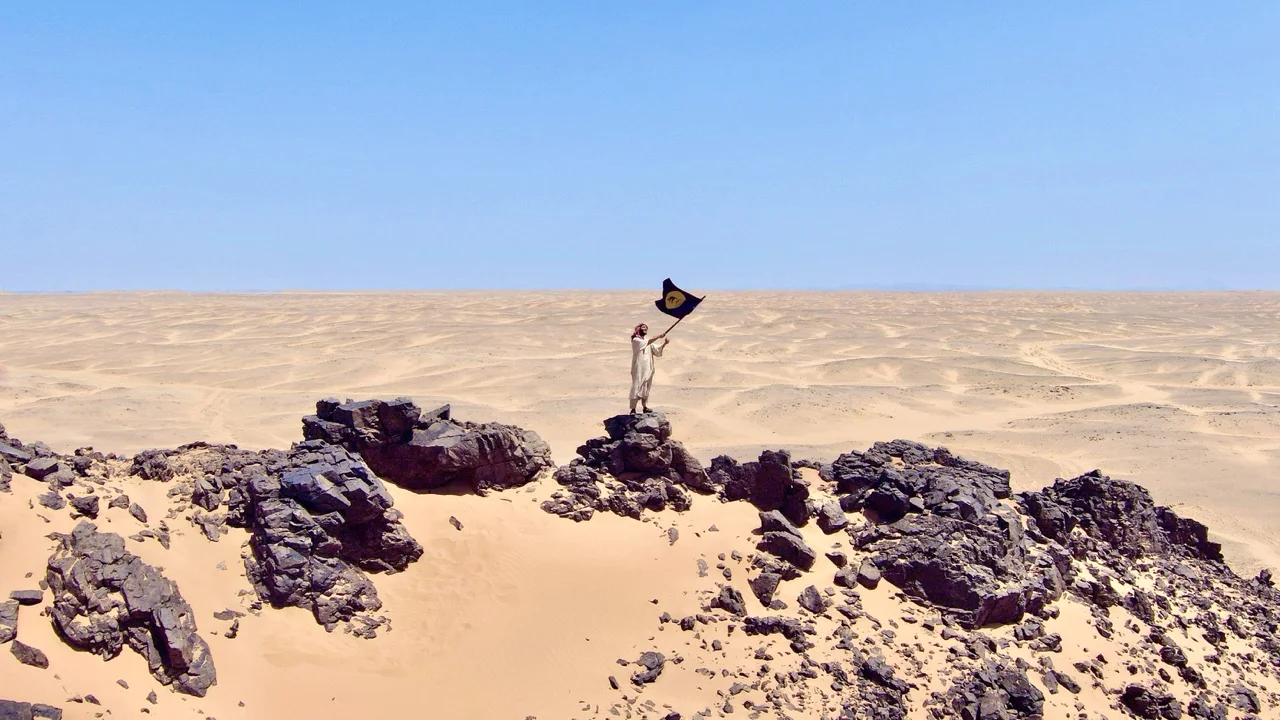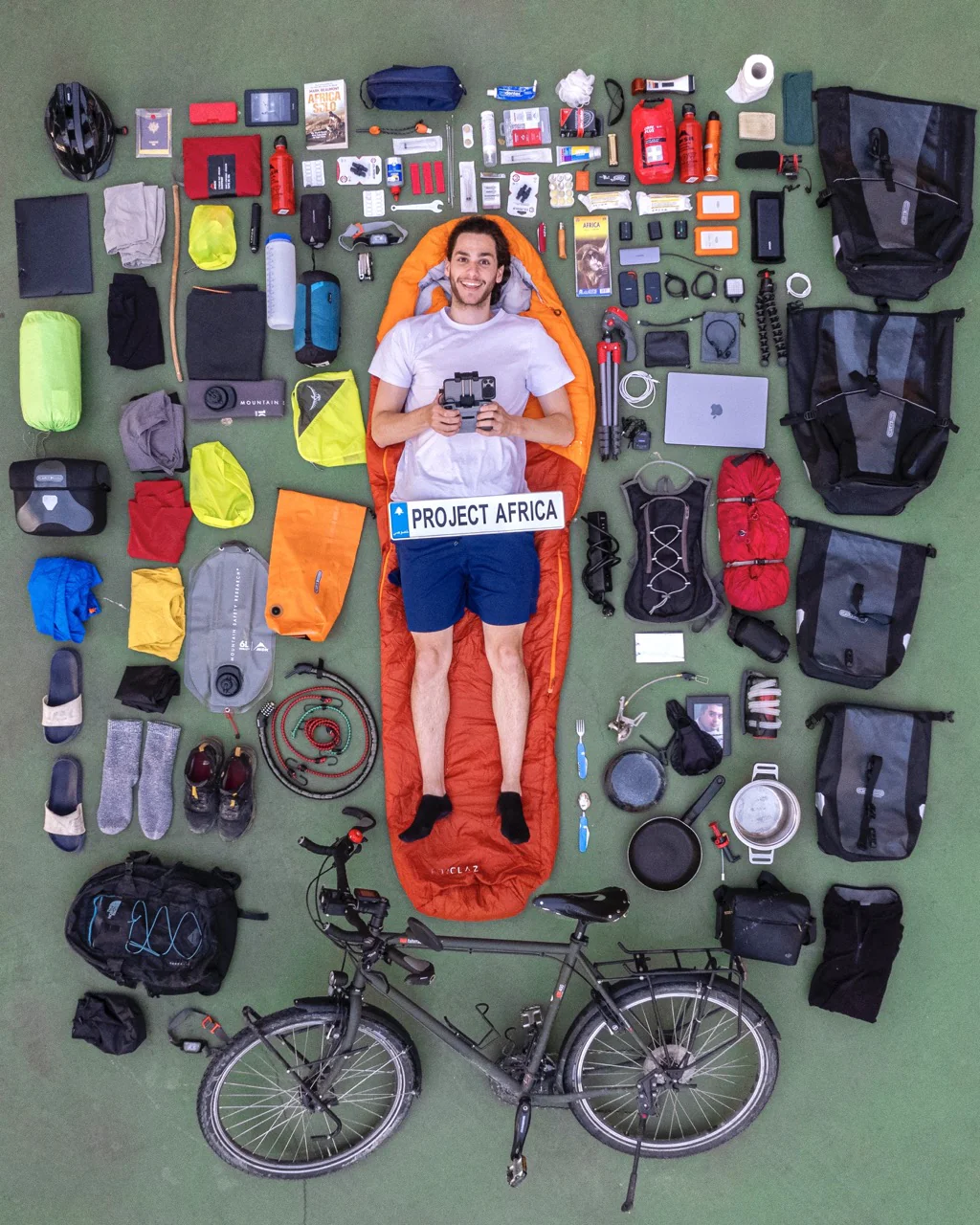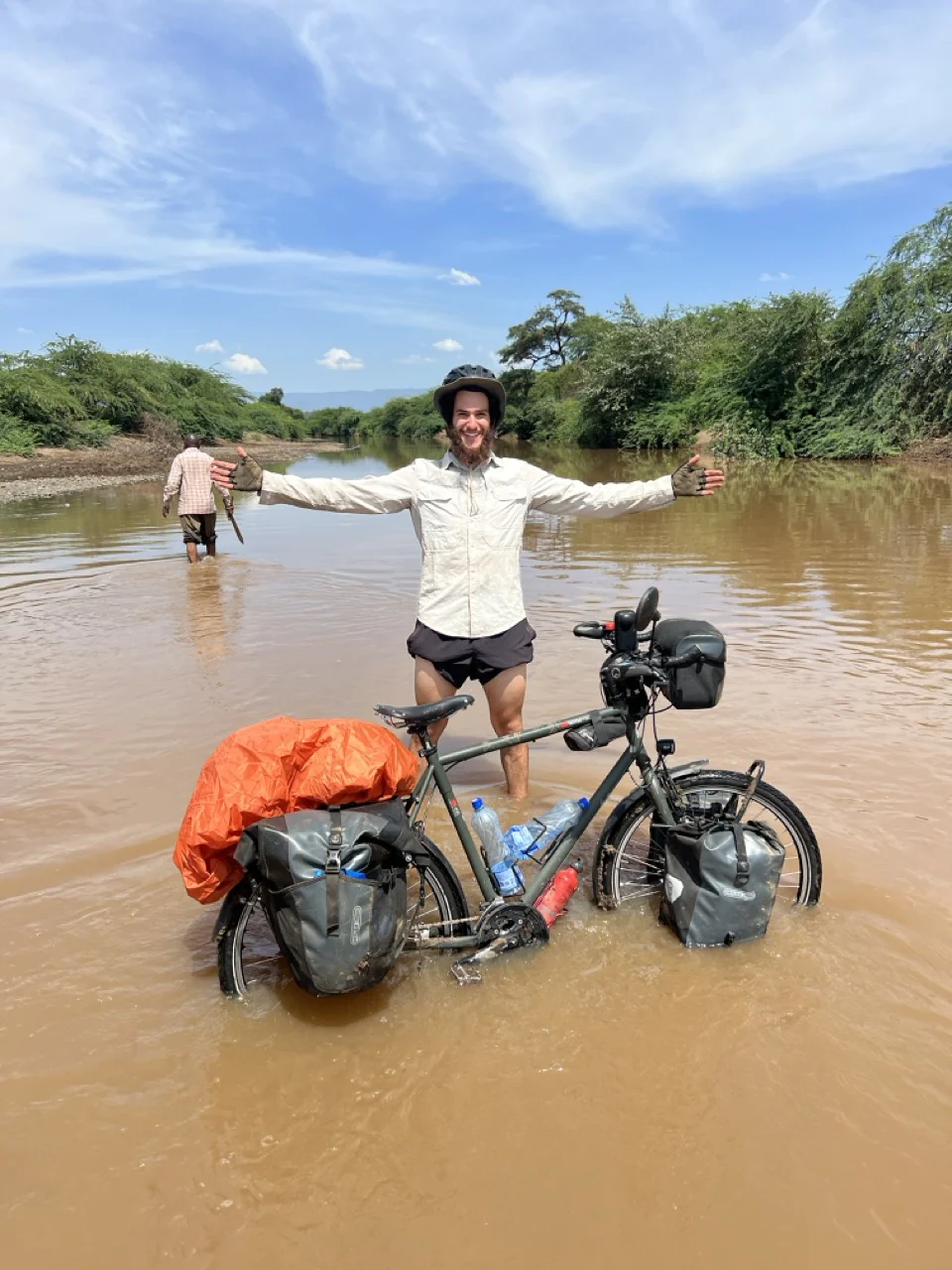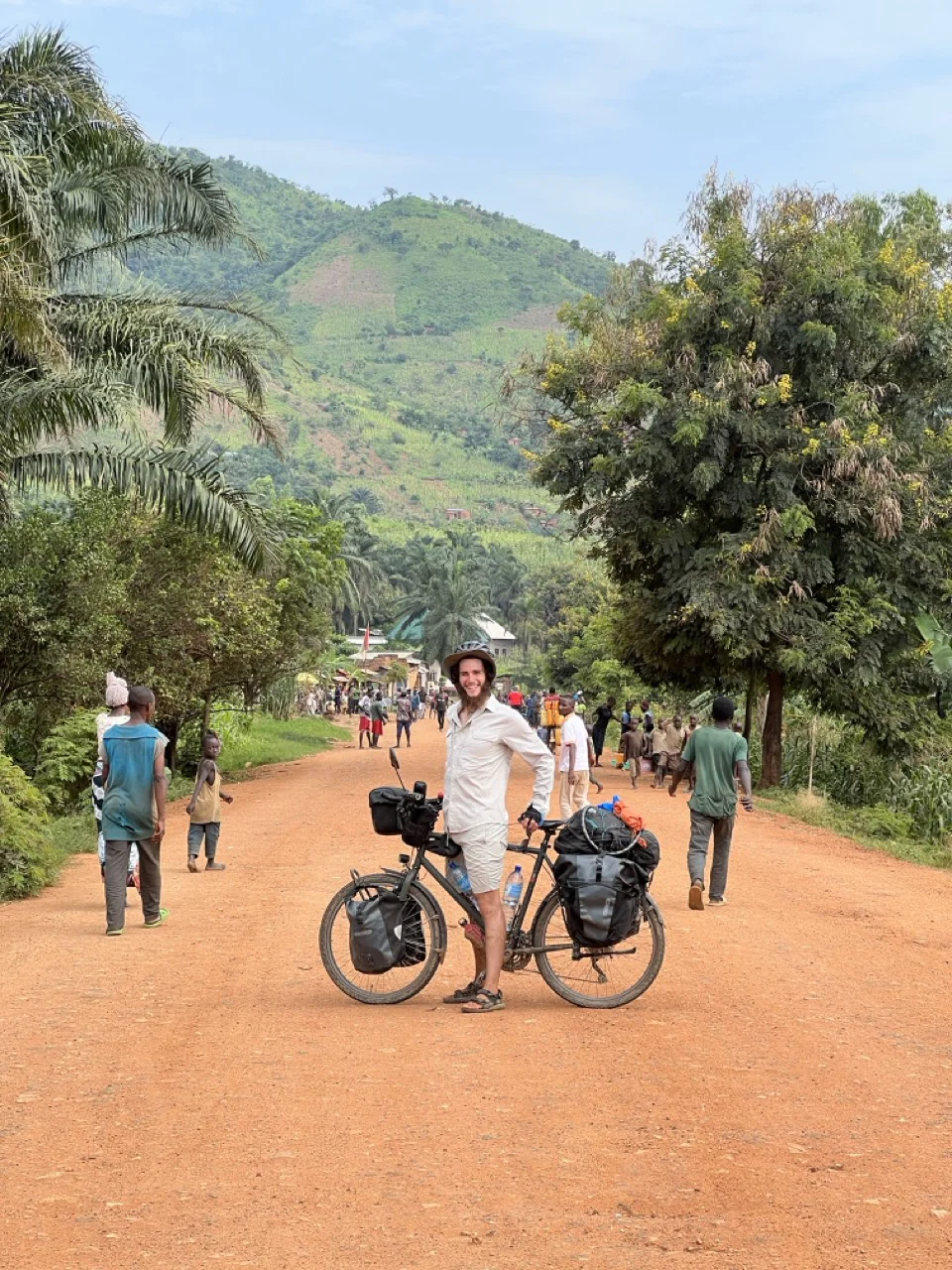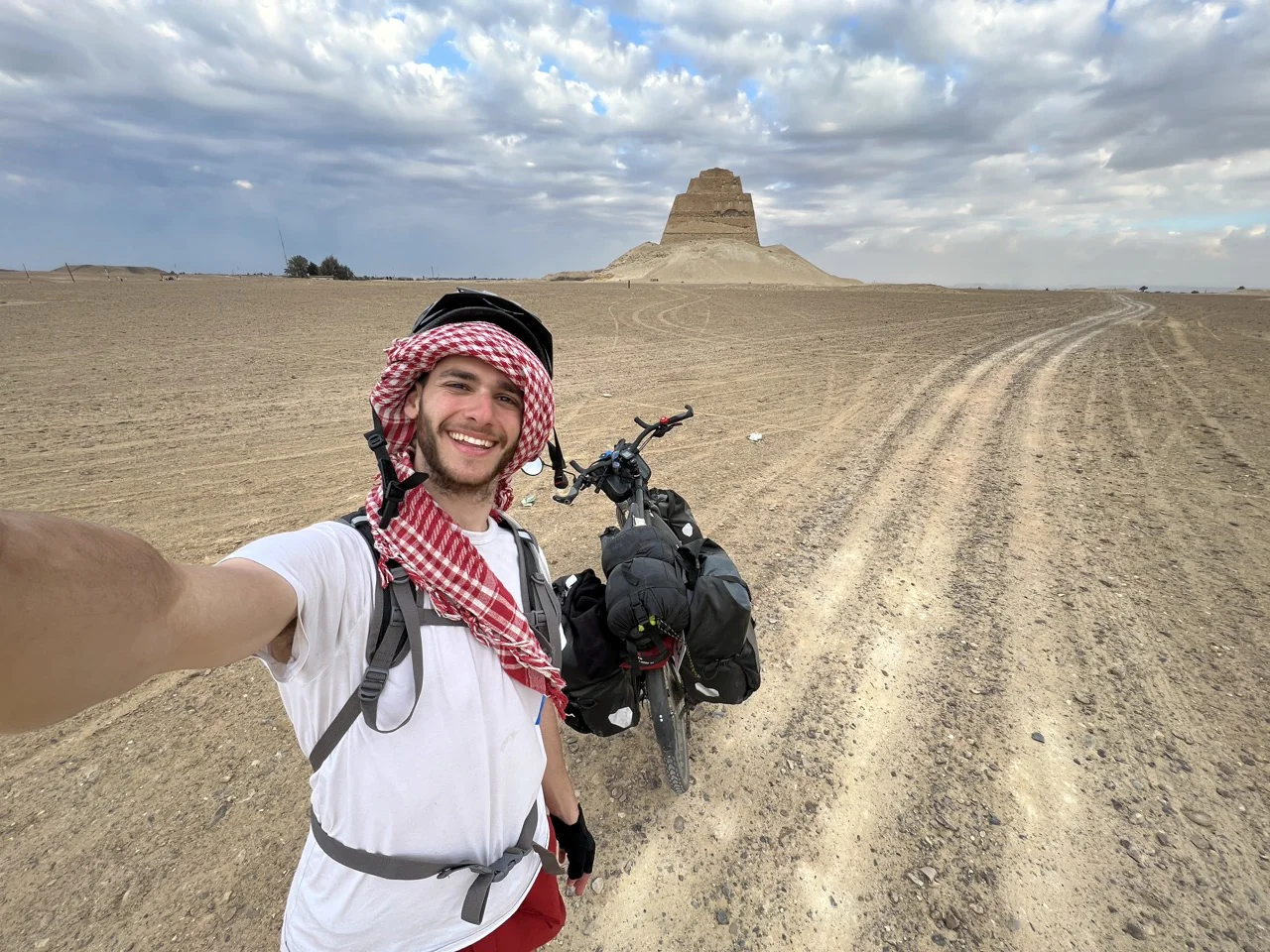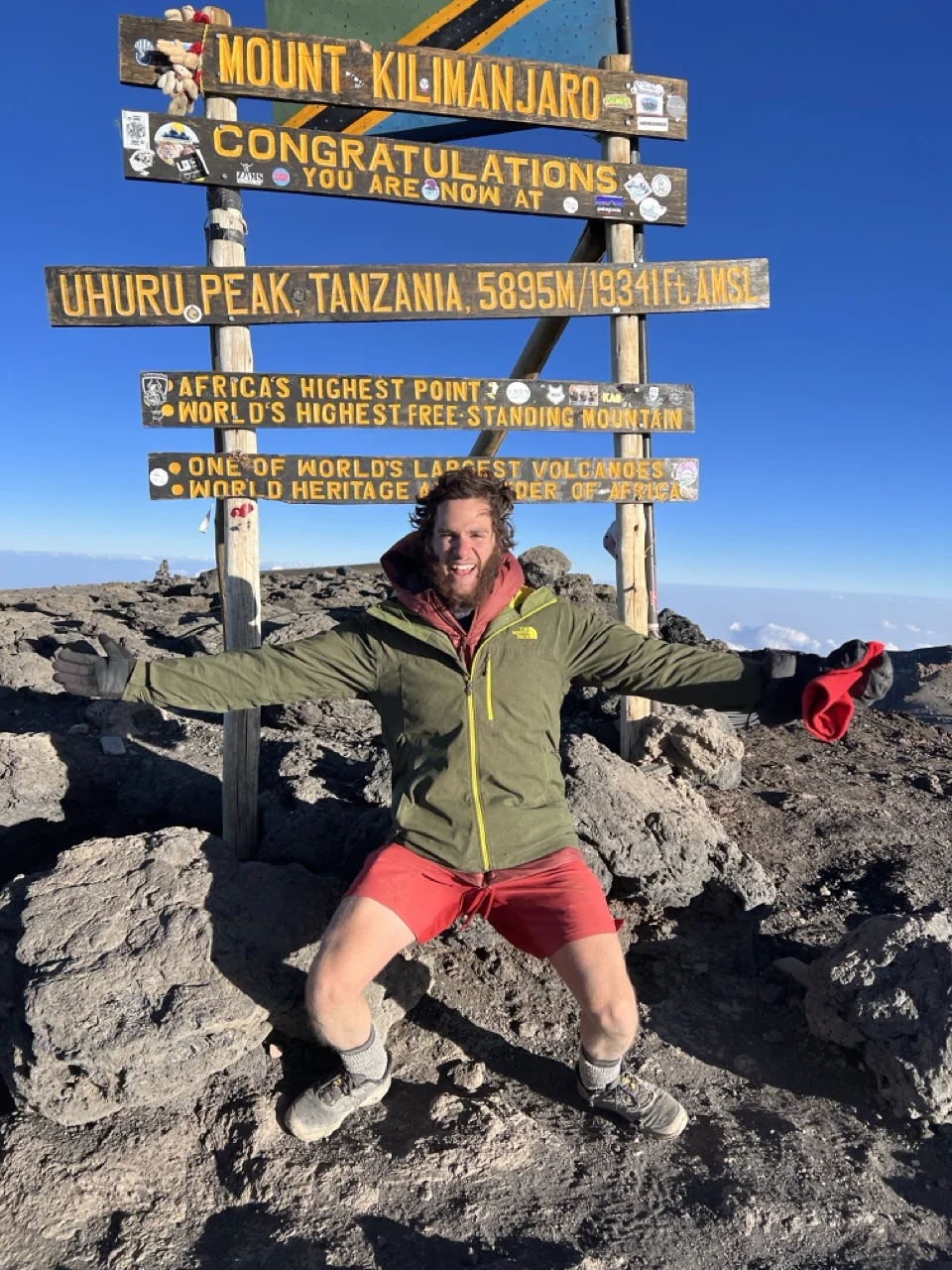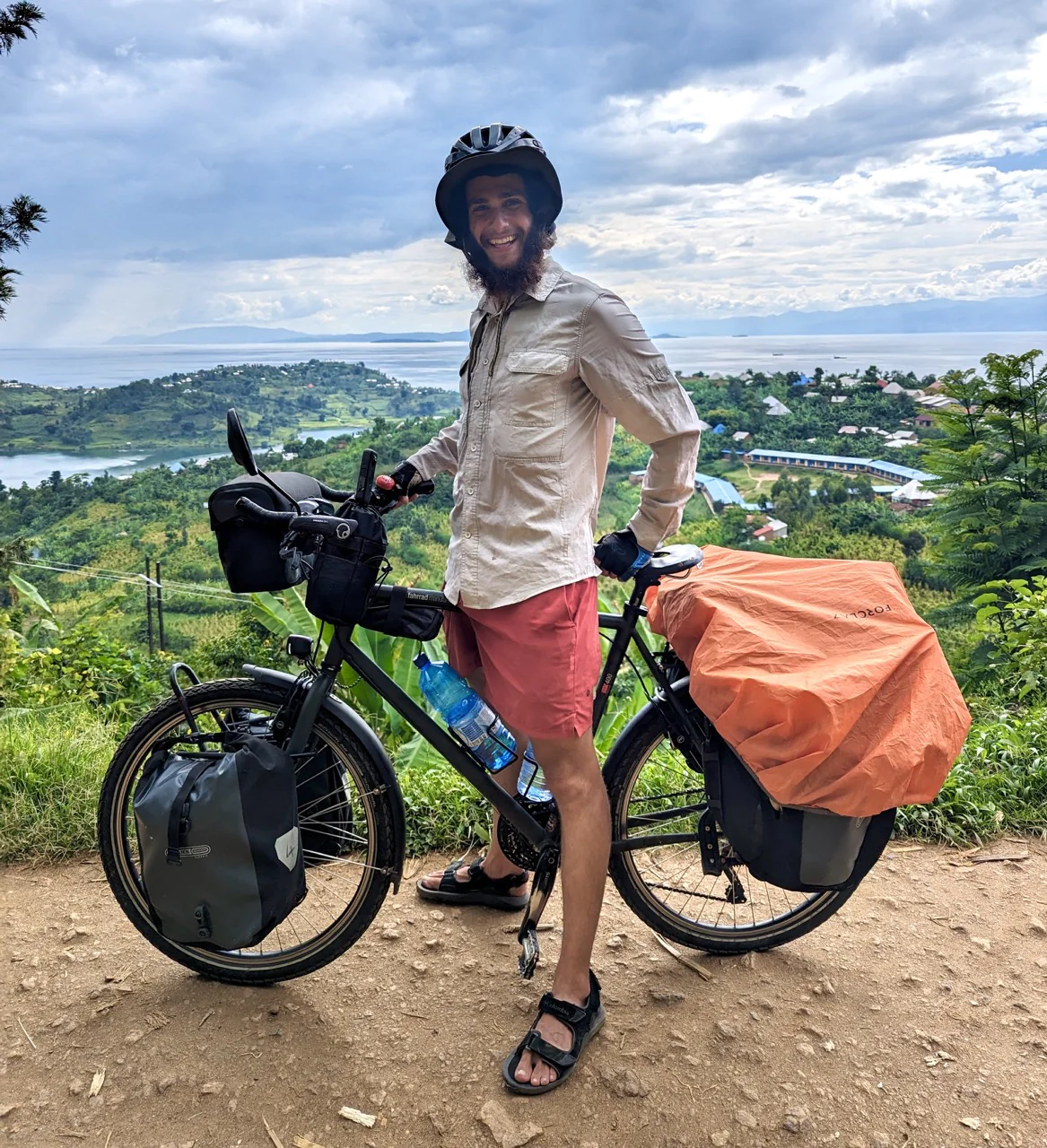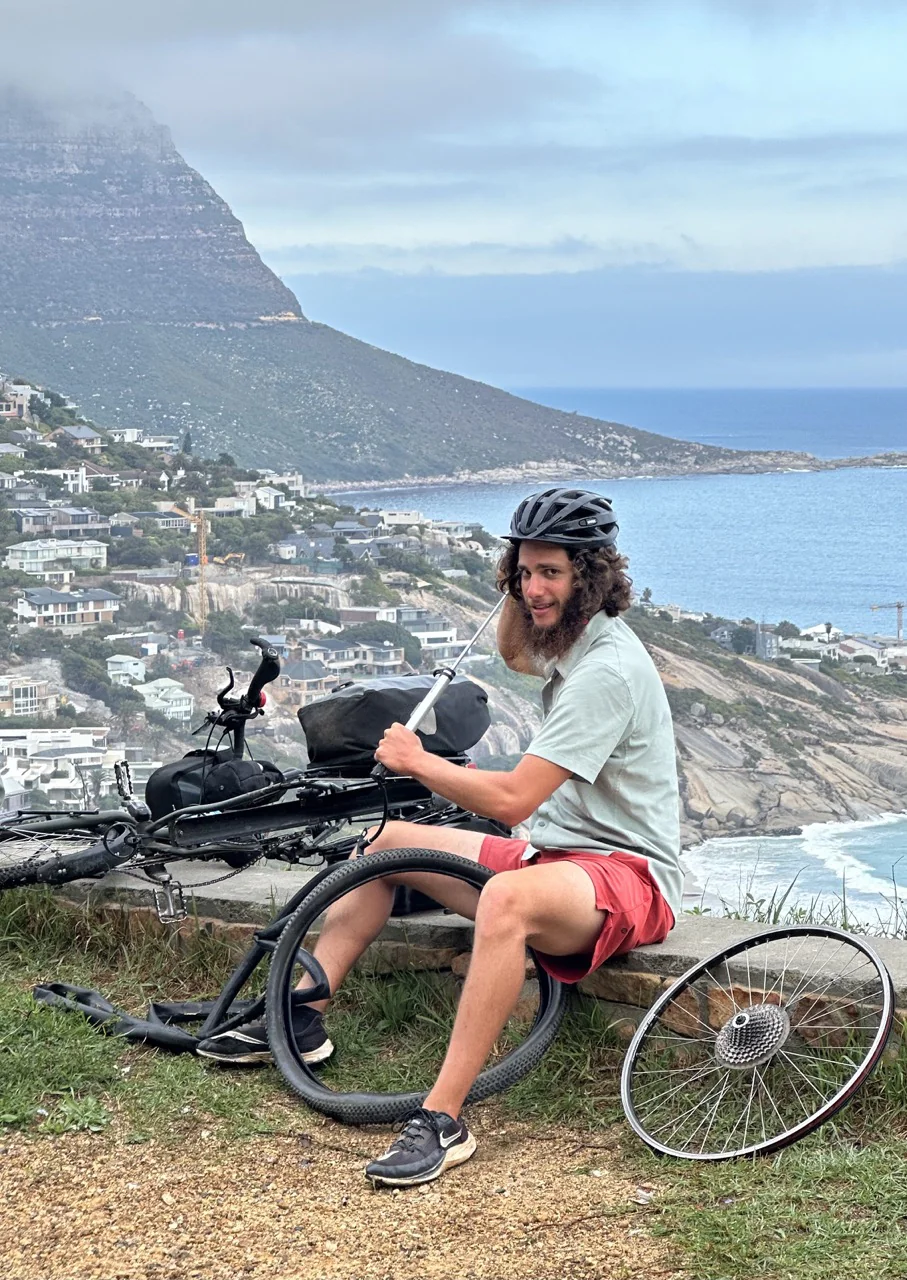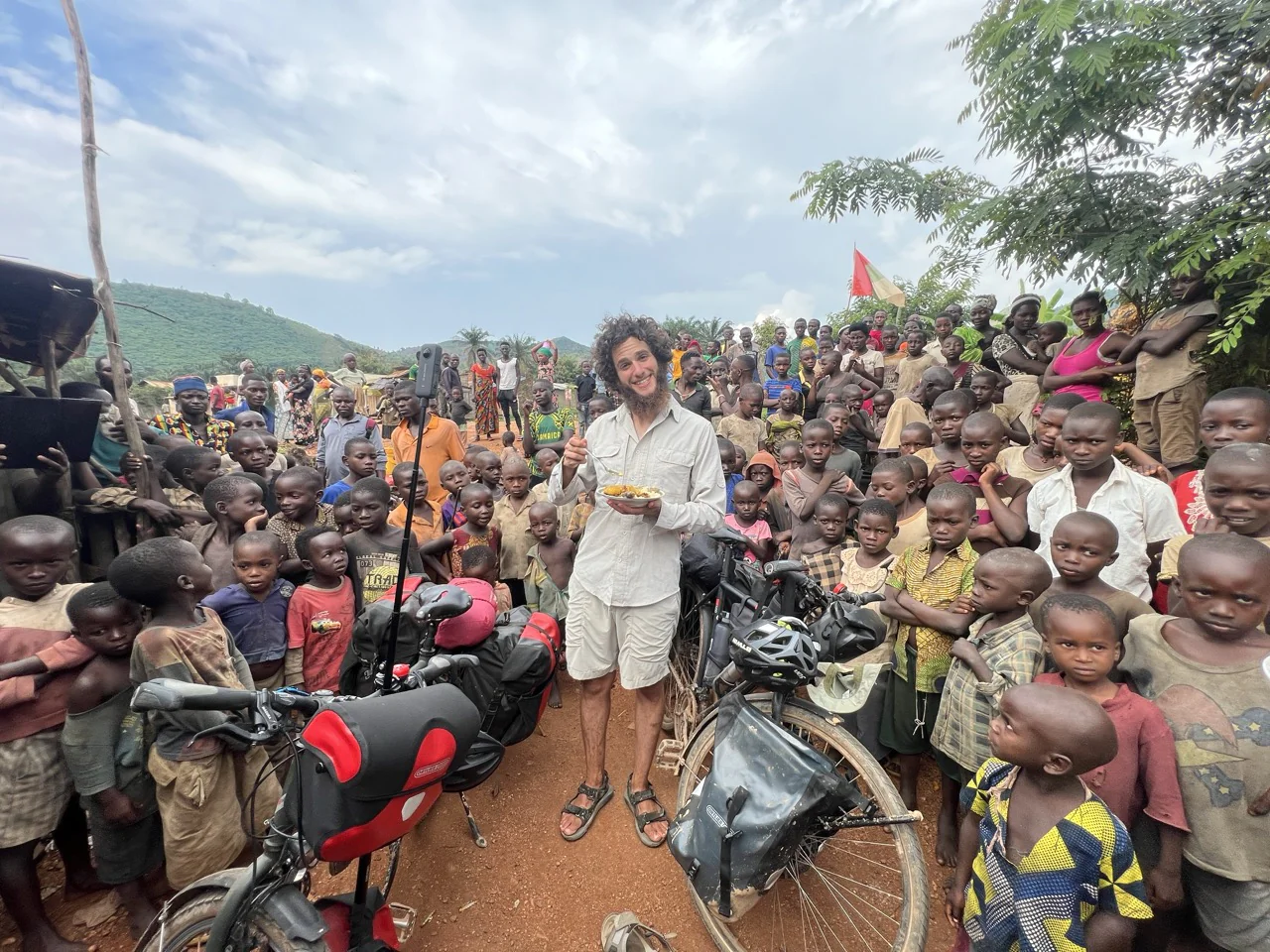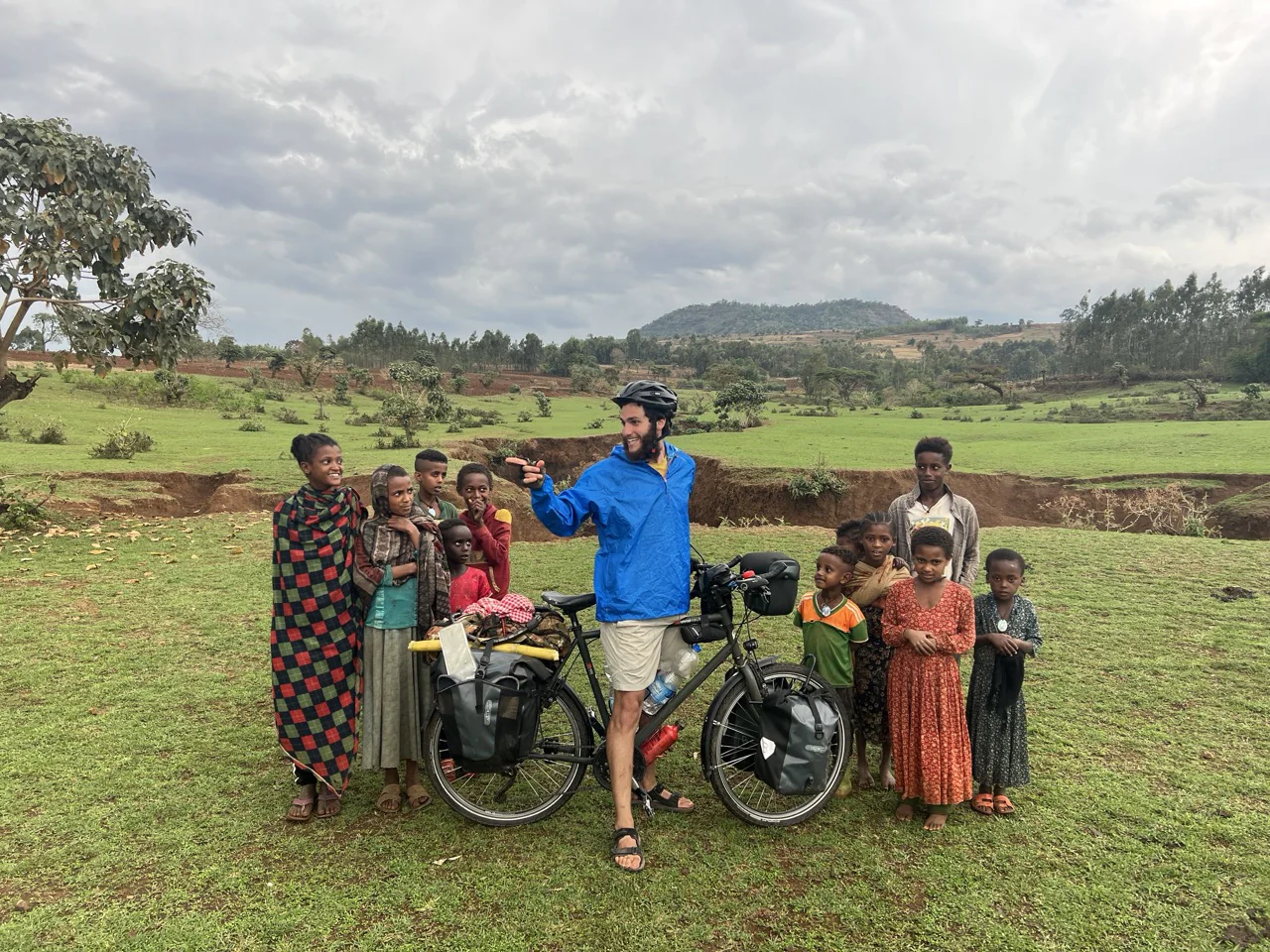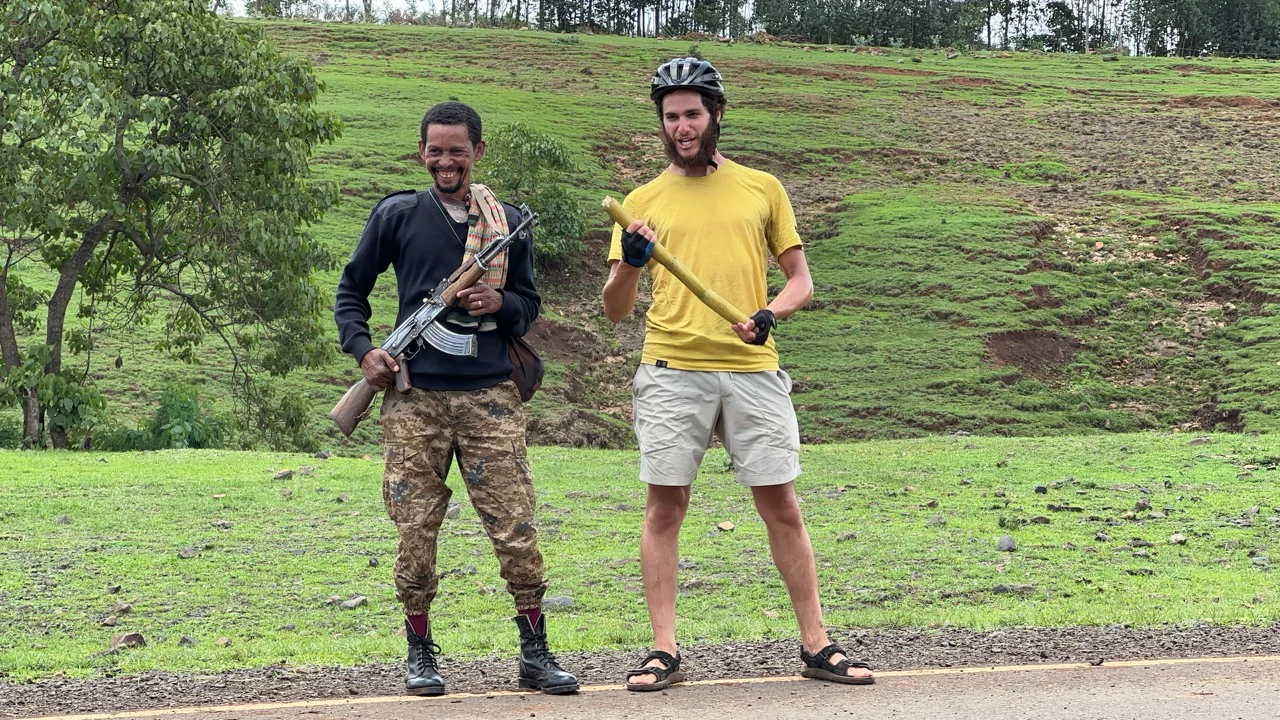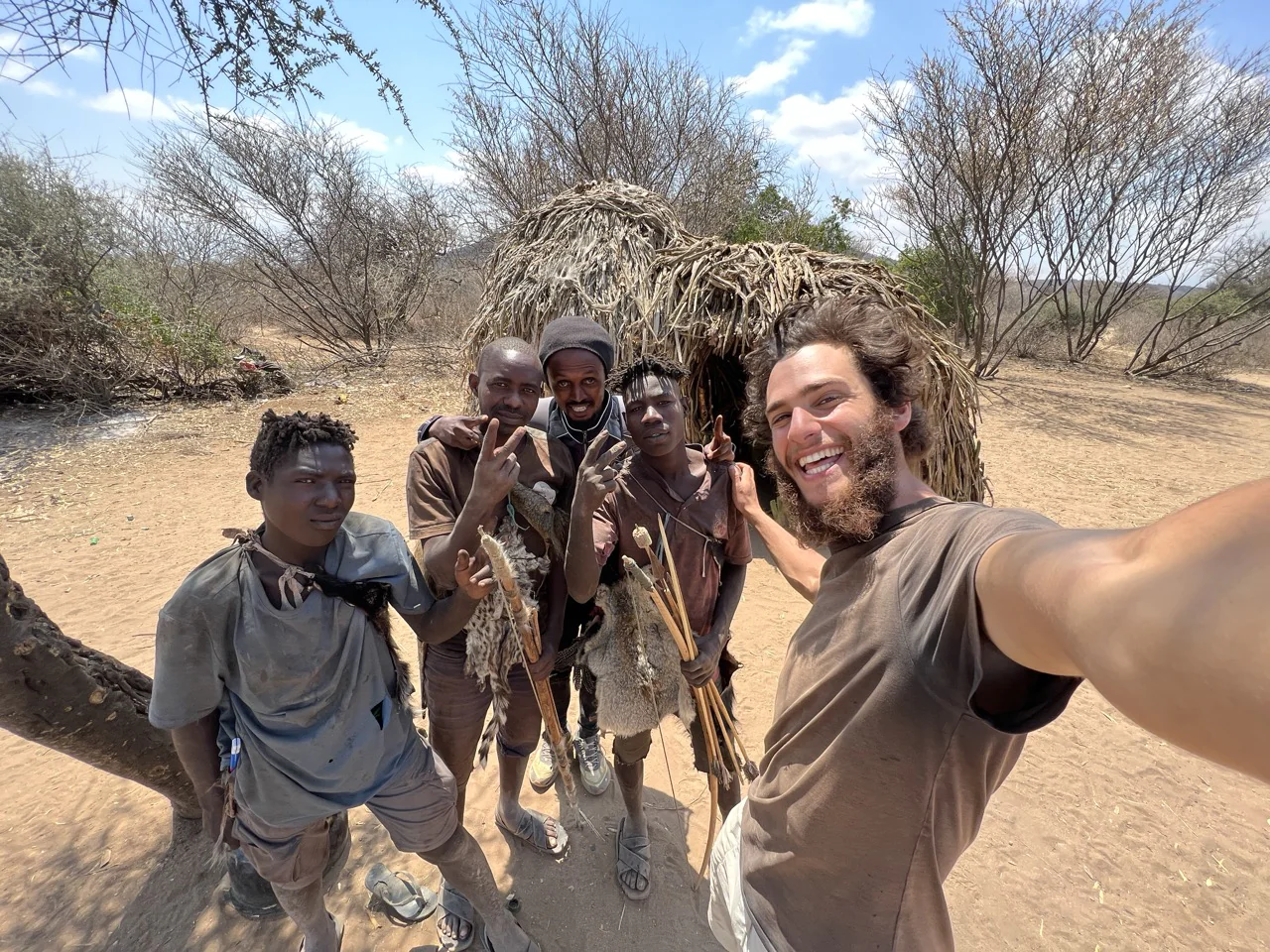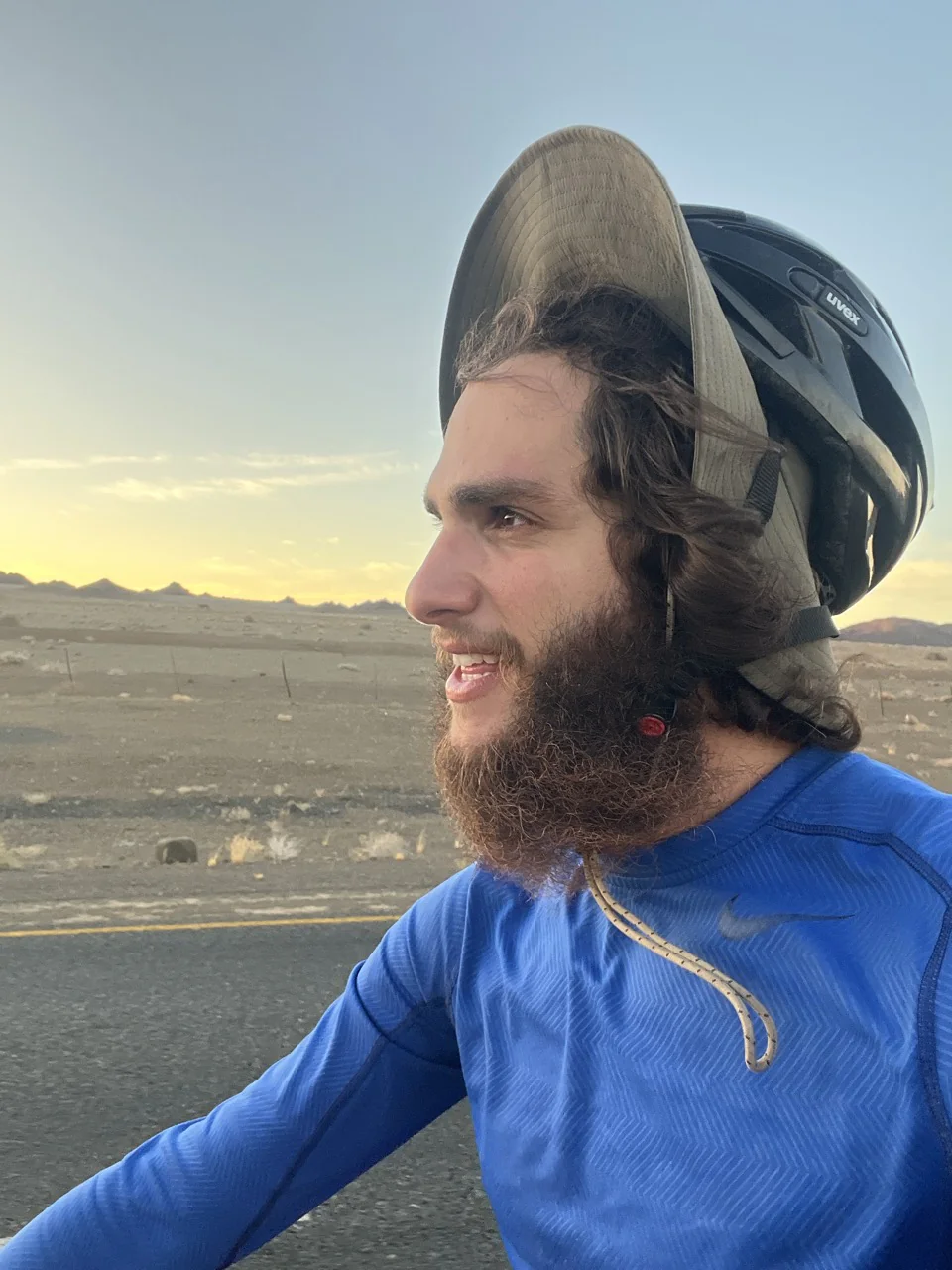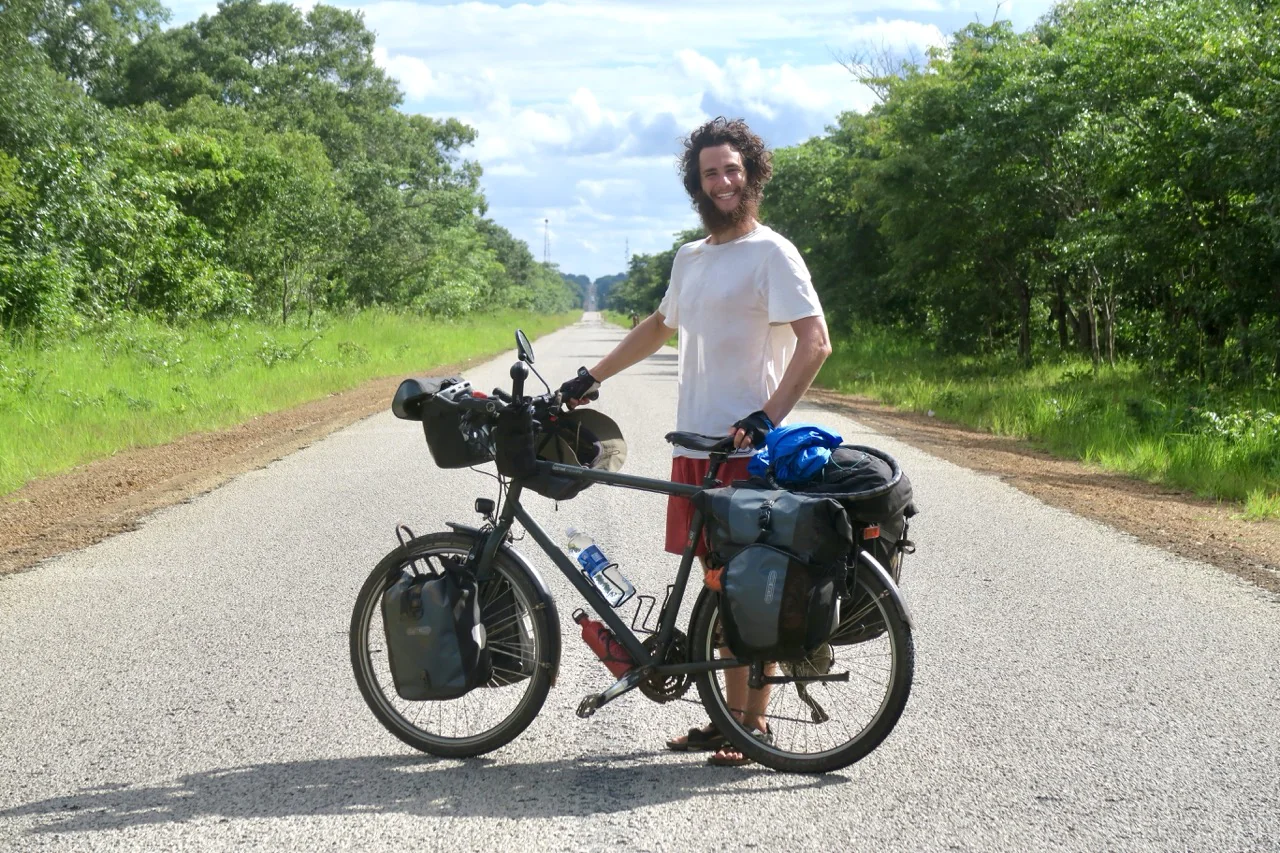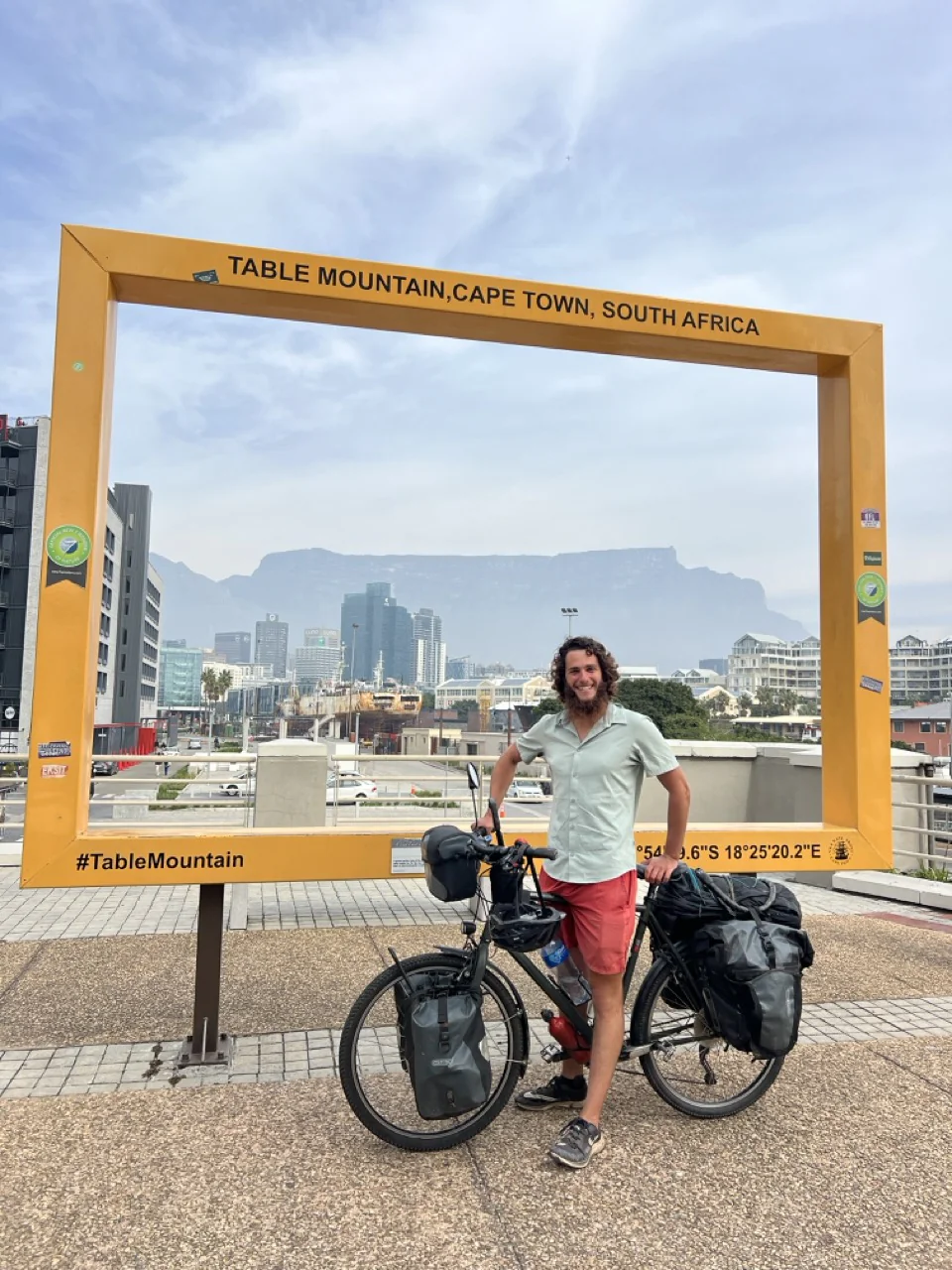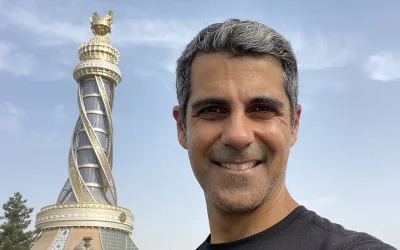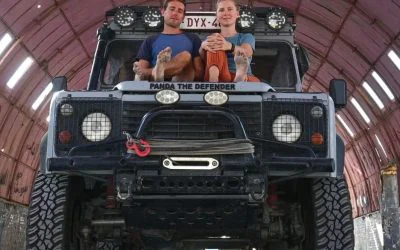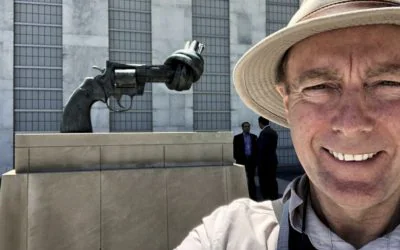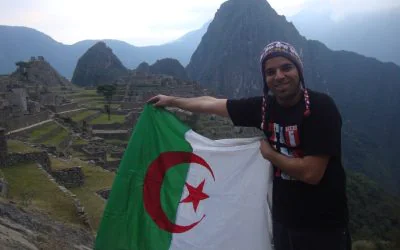There are interviews.. and there is this. If you read only one piece of NomadMania content from the past 10 years, please let it be this. Lebanese-born Roberto Helou was nominated for a NomadMania Award in 2023 for best digital creator for his entertaining, educational and always sincere coverage of his extensive bicycle ride from Egypt down to the tip of Eastern Africa all the way to Cape Town.
He could have been nominated for intrepid or even for biggest traveller, and given his social conscience and empathy, quite possibly for the Most Purposeful Traveller award as well. Given that Roberto is clearly a terrific all-rounder, this impressively mature traveller has a story to tell. As part of our overlanding month, we are very happy to present his.
By the way, here is Roberto’s profile on NomadMania showing many of his travels and his path from Egypt to South Africa.
Roberto, tell us a little about your early life and how your interest in travel developed.
Ever since childhood, I dreamed of becoming an explorer, venturing to distant lands and uncovering new landscapes, cultures, and perspectives on life. I was fascinated by atlases and maps and driven by a deeper curiosity about the natural world and the human experience. When I was six, my friend Augustin and I memorized every flag, country, and capital, impressing our school supervisors, who would quiz us during recess just for fun.
But in reality, those dreams were just the illusion of an escape from my sheltered existence. Beyond the borders of Lebanon, the country I grew up in, I had seen little of the world. I felt confined, and the pressures of school only intensified my craving for freedom—freedom to move, make choices, and explore a world far more extensive than what books, small adventures, or the classroom could offer.
As a teenager, I found limited ways to exercise this freedom by organizing hikes, camping trips, and treks—seeking adventure and discomfort where I felt most alive. At the same time, I fell in love with movies, documentaries, and books that were alternative passports to different realities of this vast world. But I wasn’t just consuming stories; I began telling my own and the one of Lebanon, capturing moments through photography, writing, and videography, blending my creative expression with my thirst for adventure and my love for sports and the outdoors.
When I turned 18, I left for university in Australia and finally began to witness the new horizons I had always longed for. Traveling around the region in my free time, I saw firsthand what connects us as human beings and the potential of how much there was to learn from traveling. It became addictive, and now I have the privilege of exploring the world at will through my work as a filmmaker, sharing those experiences and learnings with anyone curious enough to listen—just as I once was.
When and why did you decide to undertake your bicycle ride from Egypt to South Africa?
Eight years ago, while still in school, I felt unfulfilled and aimless. One thought kept haunting me: If I died today, would I have done anything meaningful for the world or myself? In a moment of procrastination, I glanced at a world map, and a dream began to form—what if I cycled across Africa, from north to south? It was a daunting and seemingly absurd idea, but deep down, I felt compelled to make it happen.
I followed my heart and backed it up with reason, identifying three core pillars guiding me on this journey. I knew it would be a defining experience in my early 20s—a time when I had the freedom to explore without many responsibilities or resources.
Here’s why I chose to take on this epic expedition:
1) Learning from and documenting a misunderstood continent
Africa, to many, is often reduced to simplistic narratives of poverty, war, and wildlife. But I knew there was so much more to this rich, diverse continent, and I wanted to experience it firsthand—not through books or media, but through real, lived experiences. Consequently, one of the primary purposes of the journey was to document and share the stories I would encounter and learn from.
Armed with a bicycle, a microphone, a camera, and a laptop, my goal was to create content that would entertain, educate, and inspire. I wanted to tell stories of people, places, and the crazy adventures that stood out—stories that bridge cultural divides, promote local tourism, and encourage open-mindedness, curiosity, and boldness. Most importantly, I hoped to contribute to the global conversation on sustainability. Building a more durable future for our planet and society is, after all, the challenge of our generation.
2) A Lifestyle of Adventure
Another reason for cycling across Africa was to experiment with a lifestyle rooted in adventure and exploration. Humanity has spent most of its existence as nomads—our minds and bodies are wired for movement and discovery. Yet modern life has made us sedentary, driven by convenience and overstimulation, disconnected from our instincts.
By embracing a slower, more intentional way of traveling, I wanted to distance myself from the meaningless hustle of modern society. I sought to reconnect with what truly mattered—experiencing the world through a minimalist, eco-conscious, and human-powered journey. Cycling hits the perfect balance: It’s faster than walking and slower than riding in a motorized vehicle, which allows you to immerse yourself in the environment, engage with people, and appreciate the small details that make the journey worthwhile. This expedition allowed me to pause, reflect, and think deeply about how my work could impact the world and the perception of Africa, its people, and cultures.
3) A Rite of Passage
Finally, the last key reason for cycling across Africa was to step outside my comfort zone, test my limits, and reinforce my sense of purpose. To me, exploration is more than just discovering new places; it’s an act of self-reflection and growth. It’s about understanding who you are beyond societal expectations and the life you were handed. I saw this journey as a way to break free from the belief system I grew up with and forge my own path.
Cycling across Africa was my way of transitioning from childhood to adulthood. It represented a clear line between who I was and who I aspired to become—a project that would change my life, both figuratively and literally. In a world shaped by globalization and uncertainty, this journey became a search for meaning, exploring history, culture, geopolitics, different ideologies and ways of living, and abundant wildlife nature. Above all, it was an opportunity to challenge myself physically, mentally, and spiritually, making it the ultimate rite of passage because exploration is ultimately introspection.
In essence, this journey was about more than cycling across a continent. It was about personal growth, adventure, and a deeper connection to the world—a search for meaning, purpose, and a way to make a difference.
To what extent did the trip go as planned or not? Tell us a little about the preparation, the planned route, how/if it was modified and other changes as you went along.
When looking at the map of Africa, I initially considered cycling from Casablanca to Cape Town. Honestly, the alliteration just sounded appealing. But after doing some research, I learned that Cairo to Cape Town was actually a thing, too, and the countries along the eastern side of the continent piqued my interest more. The route I ultimately chose was a blend of specific places and regions that intrigued me and areas I needed to avoid for safety reasons.
I read extensively on safety concerns, consulting news sources and government advisories to check for open borders, visa requirements, and any political or security issues. Sudan, Ethiopia, and northern Kenya were marked as “Do Not Travel” zones due to conflicts, while Somalia and South Sudan had significant risks due to terrorism and civil unrest. There was a clear distinction, though—local knowledge, gathered online and from people along the way, helped me assess the actual risks on the ground.
Regarding physical preparation, I didn’t do much apart from a five-day cycling test in Lebanon to get used to my gear and the physical strain. It was tough, but I wouldn’t let that discourage me from starting the journey.
I ended up cycling through Egypt, Sudan, Ethiopia, Kenya, Uganda, Rwanda, Burundi, Tanzania, Zambia, Botswana, Namibia, and finally South Africa. However, the trip could have taken a very different turn. I narrowly avoided two wars in Sudan and Ethiopia, and northern Kenya was hit with severe floods shortly after we passed through. The war in Sudan erupted just a week after we left, and Ethiopia descended into civil unrest the same hour I passed into its borders, evolving to a status quo where massacres are now occurring in towns I cycled through only a few months prior. It underscores how unpredictable Africa can be and the importance of staying flexible and ready to adapt when circumstances change.
In summary, my approach to planning involved outlining key points of interest and remaining flexible to adjust to whatever might happen. The plan was never rigid—it was built on a foundation of curiosity, caution, and adaptability, which allowed me to handle the unexpected as it arose.
So, what were some of the biggest challenges you faced during the ride?
Three significant challenges come to mind:
1) Deciding when to film and what to keep private
It was exhausting trying to balance what moments to capture and what to keep for myself. I firmly believe that happiness is only real when shared, but there’s a point where sharing everything can be too much. Plus, filming inherently skews the experience because you rarely capture the terrible moments, creating a biased version of reality. Deciding what to film—whether it was good or bad—was a constant challenge. Filming every day for 16 months straight was also incredibly taxing and led to burnout, which brings me to the second challenge…
2) The physical and mental toll of constant uncertainty
After a year, the excitement of not knowing what the next day will bring starts to wear off. Every day I faced the reality of not knowing where I’d sleep, what I’d eat, or how my body would handle the journey. I dealt with gear problems, unpredictable dangers, and the uncertainty of the people I’d meet along the way. Initially, it’s thrilling, but it becomes mentally and physically draining after a while. What made it harder was the lack of proper rest days. If I wasn’t cycling, I was filming. If I wasn’t filming, I was editing. If I wasn’t editing, I was talking to locals to learn more about the culture. The journey didn’t allow for many actual breaks, and the weight of it all hit me harder as the trip went on.
3) Unpredictable weather and daily risks
Extreme weather was another challenge—whether it was unbearably hot or constant rain, it made everything more difficult. On top of that, the risk of encountering dangerous animals, civil unrest, war, rebel group activity, and not knowing how people I’d meet would react to me added a layer of stress every day.
These three challenges—constant filming, physical and mental exhaustion, and unpredictable conditions—created a heavy mental burden and led to moments of burnout. It was stressful, anxiety-inducing, and draining. But looking back, those struggles are what made the journey truly worthwhile and taught me the best lessons.
And what were some of the most memorable joys? Give us some specific examples of things that happened that will forever remain in your memory.
There are countless moments of joy I can think of, but here are a few that come to mind:
- The first week of the adventure in Egypt, from Cairo to Asyut
That week felt like the first time I had free will ever. Cycling alongside the lush fields of the Nile, punctuated by ancient pyramids and palm trees, I would stop anytime I wanted to share tea and dates with locals and engage in conversations. Though myself and my unexpected group of new friends who tagged along on the journey for this time had some frustrating run-ins with the Egyptian police, it was surprisingly funny in hindsight and remains one of the most memorable weeks of my life.
- Trekking the Rwenzori Mountains on the Uganda-DRC border
This trek was one of the best experiences of my life. In just three days, I journeyed from dense jungle to tropical glaciers, eventually reaching Margherita Peak at 5,109 meters. The spiritual and mystical atmosphere of the cloud forests, alpine lakes, and bogs full of waterfalls is unlike anything I’ve ever seen, and it was hard to believe I was near the equator with such a setting around…
- Cycling the Congo Nile Trail in Rwanda
Fresh food, warm and friendly people, many curious kids, and breathtaking landscapes—this hiking trail offers endless green hills, rugged gravel roads, rivers and field crossings, and serene mountain lakes. The uphills and tight tracks are indeed not made for cyclists, which made the whole thing a lot harder and consequently funny.
- Chilling in Cottar’s Conservancy in the Maasai Mara, Southern Kenya
This place felt like a real-life Garden of Eden—rolling in the lush green grass where I saw hundreds of thousands of mammals as far as the eye could see, swimming in rivers and waterfalls where giraffes came to drink and spending time with the Maasai people, learning about their plant medicine and culture.
- Celebrating Virgin Mary’s Day in Finote Selam, Northern Ethiopia
The road from Dangla to Debre Markos in the Ethiopian highlands revealed stunning and rapidly evolving landscapes, vibrant local life and markets, religious celebrations, live music events, and something always happening on the road. The people here were some of the friendliest I met in Ethiopia, a rarity.
- Exploring the Danakil Depression in Eastern Ethiopia
The hottest inhabited place on Earth felt like another planet. Between active volcanoes, boiling lava lakes, salt seas, ancient tribal practices and ways of life of the Afar people, and rainbow-colored rocks, it was an extraordinary experience. The group of people I was with there made the whole adventure so much fun.
- Spotting the rare Ethiopian wolf in the Simien Mountains, Northern Ethiopia
At 4,000 meters above sea level, during a hailstorm sunset on the way to Ras Dashen, Ethiopia’s highest peak, I witnessed the rarest canid in the world from quite close on a crest where many of the Giant Lobelias that make the area so unique had burnt recently in a mountain fire.
- Cycling the Wadi Halfa to Dongola road, North Sudan
In the heart of the Nubian Desert, one of the world’s most remote regions, where the silent Sahara desert meets the roaring Nile, we were hosted by local farmers and gold miners who shared all they had with us out of pure kindness.
- Camping in Bir Tawil, Egypt/Sudan border
Spending a night under the Milky Way in the last true “no man’s land” was surreal. The peace and solitude were unmatched, hundreds of miles from any permanent settlement in a land that belongs to no country.
- Celebrating the New Year in the Qaroun desert, Egypt
Some friends and I camped near ancient, abandoned villages still being excavated. The sand was littered with small pottery remnants of history for miles and miles around. Unbelievable architectural structures and hieroglyphs, petrified forests, and desert plateaus overlook Fayum City on the other side of the Qaroun Lake. A special place to start the New Year.
- Getting sugar highs with sugar cane juice on the road from Qena to Aswan, Egypt
While still trying to dodge the Egyptian police, I would drink the most refreshing beverage in the world: three glasses of freshly pressed sugar cane juice at least, daily. I visited countless ancient Egyptian temples and tombs, probably some of the very few highly touristic locations in the world that are still worth visiting. Arriving in Aswan meant finishing the first chapter of the journey, and the feeling was blissful.
- Reaching the summit of Mount Kilimanjaro in shorts, Tanzania
After seven days of singing, dancing, and laughing with an incredible group of climbers and porters, I made it to the roof of Africa, at -20 degrees celcius, pushing myself to the limits.
- Climbing dunes in the Namib Desert
Gigantic sand structures carved by roaring winds met the roaring Atlantic Ocean in a stunning display. At the edge of the oldest desert in the world, it was one of the purest and most magnificent landscapes I’ve seen on the journey. Climbing Spitzkoppe (the Africa Matterhorn) for sunrise also deserves an honorable mention for its beauty and grandeur.
- A spontaneous date night, Zanzibar
During a storm at sea, our vacant boat rescued some people from an overcrowded boat of 20 dutch tourists that was on the verge of capsizing due to the massive waves. Among them was a girl I immediately connected with. We spent the day exploring islands and snorkeling together, and later wandered through deserted tourist villages, sharing deep conversations. It was a spontaneous and unexpected connection to remember.
- Hunting bushmeat with the Hadzabe hunter-gatherers, Northern Tanzania
I spent 4 days with three very skilled hunters—Socolo, Mandoa, and Ndunya—and every night after a hunt, we’d sit around a bonfire under the Milky Way, communicating through gestures and facial expressions. It was an unforgettable bonding experience.
- Exploring Gombe National Park, Western Tanzania
In this beautiful corner of the world on Lake Tanganyika, I observed wild chimpanzees for three days thrive in one of their last natural habitats, surrounded by lush jungles and turquoise beaches.
- Enjoying Lebanese food after nearly a year, Zambia
In Lusaka, the Lebanese diaspora welcomed us like family, and after months on the road, eating a Lebanese meal felt like home.
- Encounters with wildlife, Botswana
Cycling just meters away from wild elephants and observing meerkats dig holes at my feet and climb on my head left a lasting impression. Botswana’s wildlife is the richest and most diverse I’ve witnessed.
- Reaching the Atlantic in Strandfontein, South Africa
After a grueling day cycling against solid winds, arriving at this small fishermen’s village on South Africa’s wild west coast and feasting on fresh seafood was the perfect reward.
- Staying with young missionaries in Livingstone, Zambia
They hosted us with incredible warmth, and exploring Victoria Falls and animal reserves with them, all while talking about religion and sense of purpose was a once-in-a-lifetime experience.
- Understanding Nairobi’s most dangerous neighborhood, Kenya
I spent time with “The Pirates,” a group of ex-gangsters turned mentors, in the infamous neighborhood of Mathare. Their dedication to cleaning up the neighborhood and inspiring the youth was really eye-opening and gave me hope.
- Morning hikes up Table Mountain, South Africa
Regular sunrise hikes with a new friend from Cape Town became a peaceful ritual that grounded me in the beauty of South Africa. Cape Town is so far the most beautiful city I’ve seen.
- Acting in an Ultra-violent slum cinema movie, Uganda
Wakaliwood is the name given to Uganda’s local film scenes, and I was privileged enough to observe the ins and outs of the industry and the wild dedication the members put into their hilarious, action-packed movies. I’m acting in a film called Who Killed Captain Alex II, and I die getting shot in my private parts.
These are just some of the many moments that made this journey unforgettable. Each one enriched the adventure and created memories that will last a lifetime.
On the trip, you were joined by some other people. Tell us about them and to what extent was the trip a bonding experience (or not).
There’s easily more than 20 people that tagged sporadically along the journey, but 4 were there for longer or more consistent periods of time.
Florence has been one of my closest friends for a few years now. A third-culture kid (French-British-Indian) and avid traveler, I first mentioned Project Africa to her when we met in 2019. Her casual “I’d love to tag along for two months” quickly turned into “I want to do the whole thing.” Since then, we’ve planned most of the journey together.
Many people find it hard to believe that a straight guy and a girl can travel together as close friends without romantic feelings developing, but Florence and I are living proof. Our relationship is more like that of siblings—we support each other in countless ways, but we also argue a lot. Sharing the wild experiences of this journey with her has been a real pleasure. Some of the things we’ve been through are so unbelievable that if we weren’t each other’s witnesses, people might think we were making it all up.
Then there’s Tim. I met the 21-year-old Dutch traveler on my very first morning in Cairo at the Sudanese embassy. He told me about his current project consisting of hitchhiking from Holland to Hong Kong, and since he was passing through Egypt instead of Central Asia, he planned to hitchhike from Cairo to Port Sudan in only a few days. I convinced him to trade his plans of hitchhiking for a month with cycling instead. Two days later, he had bought an $80 bike—aptly named “Legend”—and was picking my brain on how to improve his short-form videos while we were riding along the Nile and having the Egyptian Police chasing us. Tim ended up cycling the first 1,000 km of the journey with me, and after completing his hitchhiking adventure, he rejoined us for the final 1,000 km in Namibia and South Africa. Today, he’s one of the most recognized travel content creators in the Netherlands, and the quality of his videos has improved so much thanks to his curiosity and hard work, and I’m so glad I was part of his creative journey the same way he was part of mine.
I met Liam on Mount Kilimanjaro about halfway through the journey, and we summited the mountain together. Feeling unfulfilled with his job as a waiter at a vegan restaurant in the UK, he jumped at my suggestion to join Project Africa and cycle for a few months. That “few months” turned into almost half of Africa, as he cycled from Kasese in Uganda all the way to Cape Town. Incredibly helpful, funny, and resourceful, Liam was a fantastic travel companion with whom I shared countless tough moments and some of my favorite memories of the trip.
David is a talented French-American documentary filmmaker who spontaneously joined me for two of my favorite side quests: climbing the Rwenzori Mountains and road-tripping through Namibia. His energy, enthusiasm, and restlessness made for an unforgettable dynamic. Together, we created some of our favorite memories, and even after the journey, we’ve stayed close, meeting up several times in Cape Town, where he’s based.
I met many amazing people throughout this journey and formed friendships that will last a lifetime with both locals and travelers. However, it was with Florence, Tim, David, and Liam that I spent the most time and shared the most profound experiences, and for that, I’m incredibly grateful to have had them as part of my journey.
Of the countries you visited during this ride, which one surprised you the most and why?
Ethiopia was, without a doubt, the most unique and striking country I explored during my journey across Africa. I spent three months there—longer than anywhere else—captivated by its rich culture, yet also drained both mentally and physically. The moment my friend Flo and I crossed the border from Sudan into Ethiopia, I knew this leg of the trip would be a wild ride. After spending 3.5 months in conservative Egypt and Sudan, where I hadn’t even seen a woman’s forearm, the sight of women openly breastfeeding on the streets with their faces covered in permanent tattoos just across the 10-meter bridge at the Metema border was my first culture shock.
At the border post, I initially thought they were just lazy, as the calendar still showed 2016 and the clocks were seven hours behind. But soon I realized this was simply Ethiopia’s way of life. Here, time flows differently—both figuratively and literally. The clocks are set seven hours ahead because 7 AM marks the first hour of the day, making it 1 AM in their system. As for the year, Ethiopia follows its own calendar, based on the belief that Jesus Christ was born seven years earlier than the Gregorian calendar states.
It was also the first time I encountered Amharic script, a unique language system shared only by Ethiopia and Eritrea.
At customs, we were charged a $200 “entrance fee” for my bicycle, due to a supposed “new rule,” and were held up for hours because the official assigned to process our paperwork didn’t know the Latin alphabet required to fill our documents.
To complicate things further, shortly after our arrival, the central government cut off the internet in the Amhara region. Civil unrest erupted soon after, with military trucks rolling in and civilians firing guns into the air. The government had just announced plans to disarm the Amhara region, centralizing weapons under military control. Flo and I decided it was safest to camp near the police station that night, amidst the sound of gunfire and a nine-hour church mass broadcasted through village loudspeakers.
Our visit coincided with Ethiopia’s 55-day Lent period, during which most of the population goes vegan, only to return to a carnivorous diet after Easter. Along the journey, I saw priests dressed like 16th century European kings begging in the streets to build massive churches in impoverished villages, and housing styles that transformed drastically as we moved further south.
Cycling in Ethiopia was brutal. Some days, kids would run alongside us for 4-5 kilometers up steep, 25% inclines, smiling and asking for cookies while I was struggling to breathe, drenched in sweat, and barely holding on. These kids are so effortlessly fit they could probably become world-class athletes with the right training.
As we cycled through steep, punishing hills, we tried to distract ourselves from the political chaos and the overstimulation of colors, farm animals, and quantity of people on the streets by sampling the country’s unique cuisine. The staple food, teff, is like nothing else I’ve encountered. Meals are served on injera, a spongy, slightly sour flatbread made from this grain. Ethiopia is also the birthplace of coffee and Khat, a stimulant I tried for the first time there. Fruits were very abundant and delicious, and their availability fluctuated depending on where we were.
Our experience in Ethiopia was tough, not just because of the terrain, the political turmoil, and the overall culture shock. The people, in many cases, were xenophobic and arrogant, with rocks often hurled at us as we cycled. I didn’t feel particularly welcomed, but the moments when I did—those rare connections—were truly special, even if communication remained an obstacle. Even the body language of many Ethiopian communities was different. Their way of saying “yes” involved an eyebrow raise and a distinctive sound made by inhaling through the mouth.
Ethiopia is one of the few nations in the world never to have been colonized, and one of the reasons for that is the nature of the land and how isolated it is. 80% of Africa’s mountains are found in Ethiopia, making weird limestone formations, high mountain plateaus, and extreme rainfall a regular sight. From summitting the 4 550 meter high Ras Dejen in the Simien Mountains to the scorching Danakil Depression at -135 meters under sea level, the diversity of Ethiopia’s geography and landscapes was staggering to witness. Add to that the array of ethnic groups—Amharas, Oromo, Afar, Tigrayans, and the unbelievable cultural diversity of the Omo Valley tribes.
There’s so much more to say about this puzzling country, but I’ll keep the rest for a future video! Ethiopia challenged me in every way, but it also left me with some of the most memorable experiences and fascination of my entire journey.
How do you believe you changed during the expedition?
18 months of exploring Africa are obviously life-changing to anyone doing so.
I became more open to all forms of human connection, shifting my focus away from just chasing the next stunning waterfall, savoring a new dish, or snapping a picture in front of a famous monument. What matters more now are the meaningful conversations and the special moments where vulnerability and knowledge are shared, where I truly learn something. This change came naturally through months of exposing myself, without judgment, to a diverse range of people and their stories.
This shift also ties into prioritizing experiences for my own curiosity, rather than solely for the sake of a video or an audience. It’s okay to be selfish at times because when your own needs are fulfilled, you’re able to give more in unexpected ways.
I also learned how to separate my identity from my work. I realized that my sense of self-worth had become too entangled with my journey, work, and lifestyle, creating this monolithic persona of the adventurous traveler who makes documentaries on social media.
Over time, I found myself increasingly entrenched in the mindset that my value was determined by what I achieved, rather than who I truly was. The world seemed to respond to me based on my accomplishments and the image I projected, reinforcing the idea that, in today’s society, what you show you do is often seen as synonymous with who you are.
As a result, I was always chasing extremes, constantly pushing myself out of my comfort zone, driven by a fear of missing out (FOMO) and to prove myself and reaffirm an evolving identity. But the more I raised the bar, the clearer it became that living in constant fear of future regrets leads to a life you’ll regret in the end. I realized the importance of balancing what I need with what I want, which can sometimes be two very different things.
Now, I’ve embraced routine and moderation. I still seek the extraordinary through the next learning curve and the next crazy experience, but not every day of the year. Sometimes, slowing down and embracing boredom is a gift in itself, because internal exploration is a journey of its own.
Project Africa helped me better understand who I am, allowing me to distinguish between the parts of myself shaped by nature and those molded by nurture. Ultimately, what I was searching for on this trip was freedom: the freedom to express ideas authentically in my videos, to do what I wanted without being swayed by others’ opinions. The freedom to explore, to challenge myself, to make a difference. The freedom to do the right thing, make decisions, and commit to them. And sometimes, finding that freedom requires taking the less-traveled roads, persevering in the pursuit of truth, exploration, and introspection.
What specific characters do you believe would be most suited to overlanding?
The ideal overlanders are those who demonstrate adaptability and resilience in diverse environments. They are flexible with their time, which allows them to prioritize exploration and curiosity before some of their needs or arbitrary deadlines.
They are also good at embracing uncertainty with ease while approaching potential risks with a fearless yet calculated mindset.
Strong interpersonal skills allow them to connect well with others. They maintain an open-minded, nonjudgmental attitude, showing respect for cultures that may hold values different from their own. They are also suited to giving back to the communities they pass by without creating dependency as travelers.
What advice would you give to someone planning to overland by cycling like you?
First, ask yourself: What are my true intentions with this project? Are they strong enough to carry me through the inevitable challenges? Why am I driven to pursue this? Why do I want to do this by bicycle? Why do I want to cycle this specific route/region of the world?
Once you have clear answers, the next steps become methodical:
- Ensure you have enough savings for the journey (bikepacking full-time generally costs about a third of living in a city).
- Plan the basic logistics and timeline (gear, routes, visas, points of interest, etc.).
- Start by investing in the essential gear (bicycle, tent, sleeping bag) as a tangible way to commit to the journey.
- Consider keeping a journal or any form of documentation (I picked filmmaking) to help you process things during and after the journey. Share your learnings with anyone you want (Family, friends, or an audience on social media, which can be a way to access more places and people and educate anyone on the region of the world you’re in and its complexities).
Remember not to overplan or overthink. Your adventure’s success will come from striking a balance between solid, basic preparation and the ability to go with the flow and adapt to the unexpected.
Don’t hesitate to think creatively when financing the expedition or asking for support. If your adventure holds value for yourself and others, people are often willing to be part of it somehow.
Starting Project Africa was the best decision I ever made, and I have no regrets. The timing wasn’t perfect, but I told myself: if you truly feel the call to embark on an adventure—or any project—go for it.
So, what’s next for you in terms of travel?
I have three projects coming up soon:
- I will cycle across Syria early next year for 22 days, from Busra to Aleppo, passing by the Syrian coast and many smaller villages along the way. I will make a comprehensive documentary about what this part of Syria looks like today within different communities.
- I am going back to live for a month near Lake Eyasi in Tanzania with my hunter-gatherer friends. I want to learn how to hunt with bows and arrows and collect wild honey. I also want to study Hadzane, their language, and better understand their values.
- I want to volunteer in the monasteries of Mount Athos, a peninsula in Greece where no women stepped foot for 1000 years, and document the lives of the monks there.
- I have many other video projects involving traveling to remote/off-the-beaten-path places that I won’t mention yet, but I have a very long list. But the main big thing I’m looking forward to is a potential “Project West Africa” expedition, where I’ll cycle through 28 countries and make comprehensive documentaries about every country that hasn’t had the international recognition or media attention it deserves, showcasing through them the beauty and potential of the African continent and its people.
Finally, we would like to ask: if you could invite four people to a fictional dinner (from any era in human history, alive or dead), who would you invite and why?
I thought of 10 random people while thinking about this question and it made me laugh:
The Buddha, Mark Twain, Alexei Navalny, Da Vinci, David Choe, Ernest Shakleton, Joe Pesci, Don Bosco, Jim Carrey, and Chenghis Khan. It would be interesting to have them argue on a round table, each coming from different professional, historical and cultural backgrounds, and having clashing personalities and beliefs.
P.S. Make sure to follow Roberto on instagram, facebook and youtube.
